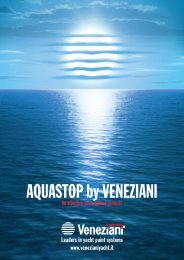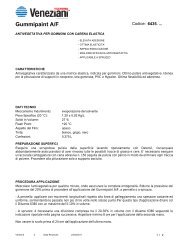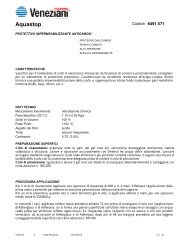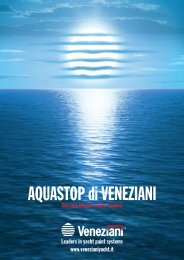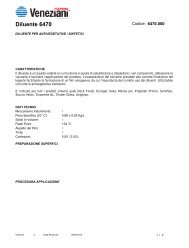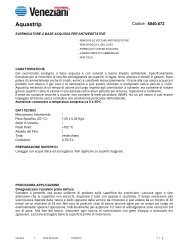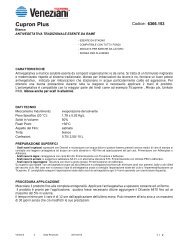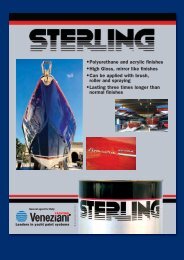3 - Veneziani Yacht Paints
3 - Veneziani Yacht Paints
3 - Veneziani Yacht Paints
Create successful ePaper yourself
Turn your PDF publications into a flip-book with our unique Google optimized e-Paper software.
5 FURTHER INFORMATION<br />
GLOSSARY<br />
ANTIFOULING, SELF-CLEANING,<br />
ERODING, SOLUBLE OR<br />
CONTROLLED LEACHING<br />
When, less than 150 years ago,<br />
McInnes in England and Gioachino<br />
<strong>Veneziani</strong> in Trieste invented the first<br />
really effective antifouling paint,<br />
this already had self-cleaning, eroding<br />
and controlled leaching characteristics.<br />
In fact, all antifoulings<br />
in order to be effective must release<br />
into the water substances which<br />
will inhibit, repel or delay the attack<br />
and development of fouling, which<br />
can be an animal (mollusks) or vegetable<br />
(weed) encrustation.<br />
Antifoulings have to be, through various<br />
means, partially soluble in order<br />
to leach. At first, the antifouling<br />
was a kind of soap, combining natural<br />
resins (like rosin) and greases<br />
(like Marseille soap). Then the<br />
leaching was controlled by mixing<br />
various natural, soluble resins with<br />
synthetic, insoluble resins (olefin<br />
resin, vinyls, chlorinated rubber,<br />
acrylics, etc.). In the 1970s, the<br />
leaching method was perfected by<br />
the use of acrylic resin copolymers<br />
and tin organic compounds and<br />
this is when the selfleaching definition<br />
was coined. Today, tin can no<br />
longer be used for environmental<br />
reasons - it is legally banned - and<br />
therefore these copolymers can no<br />
longer be used. The term self-leaching<br />
can rightfully also be used by<br />
all paints which have various<br />
means of controlled leaching. The<br />
terms self-leaching, eroding, controlled<br />
solubility, progressive leaching,<br />
self-cleaning and self- polishing<br />
are now in fact synonymous.<br />
40<br />
Only hard antifoulings are an exception<br />
to this rule.<br />
HARD ANTIFOULINGS<br />
Insoluble antifoulings or antifoulings<br />
with low solubility or erodibility<br />
are normally used on highpowered<br />
boats (35-50 knots) on<br />
propellers, shafts, flaps, motor bodies,<br />
hydrofoil and stabilising fins,<br />
waterlines and generally all submerged<br />
parts subject to extreme<br />
wear or abrasion. These are hard<br />
antifoulings. In these products, leaching<br />
of the agents which inhibit attack<br />
by the fouling does not occur<br />
by means related to the solubility<br />
of the binder but, for example, through<br />
the high concentration of biocides,<br />
whose particles are leached<br />
by contact (“contact leaching”).<br />
These products are also used for<br />
boats which are used on a daily basis.<br />
Hard or semi-hard antifoulings<br />
should also be used in brackish or<br />
soft waters or in ports with strong<br />
currents.<br />
VISCOMETER<br />
An instrument used to measure<br />
the viscosity of a product. It works<br />
by measuring (in seconds) the time<br />
taken by 100 cc of a product to<br />
pass through a calibrated hole into<br />
a cup.<br />
DRYING<br />
When a paint product is drying two<br />
moments are distinguished relating<br />
to the quantity of evaporated<br />
solvent and/or the degree of crosslinking.<br />
In this way the values “powder”<br />
dry and “touch” dry can be<br />
identified. A product is “powder”<br />
dry when any powder deposited on<br />
the film is not absorbed. However,<br />
the product is “touch” dry when it<br />
can be handled without the film<br />
being marked. The paint only achieves<br />
its maximum performance<br />
when the drying-time has completely<br />
elapsed (drying time before<br />
use). You must always follow the<br />
overcoating times given in the technical<br />
instructions.<br />
HYDROPHILIC<br />
This is the opposite of hydrophobic.<br />
A hydrophobic surface repels<br />
water and does not become wet. A<br />
gloss enamel, glass, a surface<br />
treated with silicon or Teflon based<br />
products are all hydrophobic.<br />
However, a hydrophilic surface is<br />
easily wetted and incorporates or<br />
retains a layer of water. Hydrophilic<br />
antifouling, by retaining a layer of<br />
water, reduces the friction of the<br />
hull. The friction between the layer<br />
of water retained and the seawater<br />
is less than that between seawater<br />
and a hydrophobic surface. By repelling<br />
water, the hydrophobic surface<br />
creates greater friction. The<br />
hydrophilic antifouling RAFFAELLO<br />
easily carries out its repellent action<br />
against fouling, due to the improved<br />
leaching of its active components<br />
which are in continuous<br />
and constant contact with water.<br />
ANTIFOULING LEACHING IN WATER<br />
HUMIDITY GAUGE<br />
This instrument is used to measure<br />
moisture levels in the substrate<br />
(fibreglass or wood) of a hull.<br />
Moisture levels are particularly important<br />
in the treatment of osmosis.<br />
After removing the gel coat,<br />
check that the hull “dries out” properly.<br />
Drying can be natural or accelerated<br />
(using various heating<br />
and dehumidification systems,<br />
either directly or indirectly). The<br />
moisture level must be reduced to<br />
below 10%. This can be checked<br />
with an instrument such as the SO-<br />
VEREIGN humidity gauge which is<br />
used by all the AQUASTOP osmosis<br />
treatment centres.<br />
MIXING RATIO<br />
This is the mixing ratio between the<br />
base (component A) and the setting<br />
agent (component B) in twopack<br />
products. The mixing ratio is<br />
expressed both in weight and in vo-<br />
Self-polishing antifouling Hard antifouling Hydrophilic antifouling<br />
beginning of season beginning of season<br />
end of season end of season<br />
= biocide



